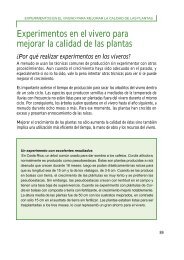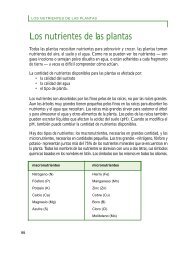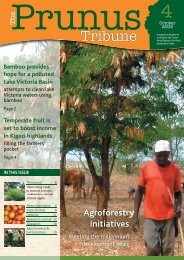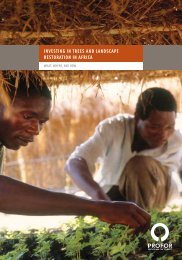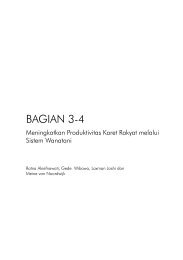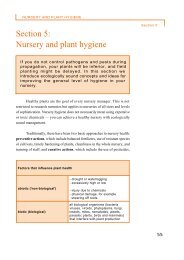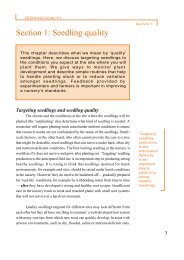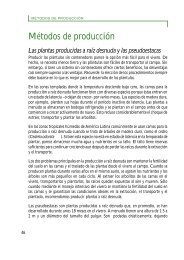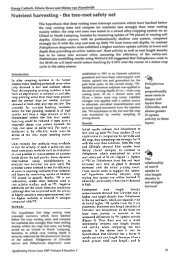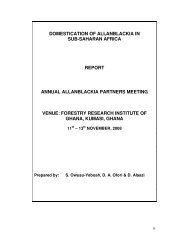Download as a PDF - World Agroforestry Centre
Download as a PDF - World Agroforestry Centre
Download as a PDF - World Agroforestry Centre
Create successful ePaper yourself
Turn your PDF publications into a flip-book with our unique Google optimized e-Paper software.
48<br />
<strong>World</strong> <strong>Agroforestry</strong> into the Future<br />
limits under some conditions. Izac and<br />
Swift (1994) argued, for instance, that a<br />
sustainable agricultural landscape might<br />
necessitate a balance between are<strong>as</strong> of exploitation<br />
of resources and are<strong>as</strong> in which<br />
they are permitted to accrue. This relates to<br />
the third challenge.<br />
Challenge 3: What are the tradeoffs<br />
between the storage of organic<br />
matter in the soil (to counter the<br />
climate change effects of incre<strong>as</strong>ed<br />
g<strong>as</strong>eous emissions) and its use to<br />
drive nutrient cycling, crop production<br />
and other ecosystem services?<br />
Socio-biophysical interactions are apparent<br />
at all scales, but primarily at the landscape<br />
scale where the impacts of decisions<br />
made by different stakeholders across a<br />
range of scales interact (Figure 1). The two<br />
Systemwide Programmes managed by the<br />
<strong>Centre</strong> (the African Highlands Initiative<br />
and the Alternatives to Sl<strong>as</strong>h and Burn<br />
Programme) have been at the forefront in<br />
developing approaches and methods for<br />
<strong>as</strong>sessing the interactions between environmental,<br />
economic, social and political<br />
factors in natural resource management<br />
(Stroud 2001; Stroud and Khandelwal<br />
2003; Palm et al. 2005). The proposal for<br />
the Challenge Programme for sub-Saharan<br />
Africa drew upon these lessons by picturing<br />
an interactive chain of cause and effect<br />
in land degradation and unsustainable agriculture.<br />
This chain links the degradation of<br />
natural resources to failures in market access<br />
and performance, thence to inappropriate<br />
pathways of system intensification,<br />
and finally to inadequate policies (FARA<br />
2003). The analysis provided in the Challenge<br />
Programme documentation serves in<br />
particular to direct attention to the ‘interactions’<br />
between these sectors of the research<br />
enterprise <strong>as</strong> well <strong>as</strong> to the issues within<br />
each of them (the fourth challenge).<br />
Challenge 4: What are the key<br />
questions arising from interactions in<br />
the chain linking resource management–system<br />
intensification–market<br />
access–policy?<br />
Integrating across scales<br />
The rules governing resource management,<br />
and the institutions making them, change<br />
<strong>as</strong> scales change. For example, rules (or<br />
the lack of them) made from the national<br />
perspective can strongly influence local<br />
behaviour and may result in significant<br />
feedback effects (Figure 1). This complexity<br />
is compounded by changes in dominance<br />
of the factors determining natural resource<br />
dynamics at different scales (e.g. van Noordwijk<br />
et al. 2004 with respect to hydrological<br />
flows and Swift et al. 2004 in relation to<br />
the significance of biodiversity). The type of<br />
management (communal or individual, government<br />
or private) apparent within the land<br />
use types and the gender and wealth dimension<br />
is also important. Thus, a range of<br />
social parameters enters the equation. These<br />
issues have been analysed by the CGIAR<br />
T<strong>as</strong>kforce on Integrated Natural Resource<br />
Management and the reports and papers<br />
emanating from that group (e.g. Campbell<br />
and Sayer 2003; Sayer and Campbell 2001)<br />
together with the framework developed by<br />
Izac and Sanchez (2001) offer some of the<br />
best analyses of the methods, approaches,<br />
successes, opportunities and challenges that<br />
face a scientific community committed to<br />
issues of ‘Land and People’.<br />
In a recent study of watershed management<br />
issues that cut across scales and social perspectives<br />
in the E<strong>as</strong>t African Highlands (reported<br />
by German 2003 and Stroud 2003),<br />
five main categories were identified:<br />
1. Issues involving the management of<br />
common property resources which compromise<br />
either the quantity or quality of<br />
these resources.<br />
2. Issues involving limited access and<br />
inequitable distribution of resources<br />
(absolute and relative shortages).<br />
3. Trans-boundary effects between neighbouring<br />
farms and villages.<br />
4. Are<strong>as</strong> in which collective action could<br />
significantly enhance farm productivity,<br />
either through incre<strong>as</strong>ed access to<br />
productive resources (natural resources,<br />
labour, capital) or through cooperation<br />
to conserve resources that are under<br />
threat (biodiversity, local knowledge).<br />
5. Are<strong>as</strong> in which collective action is<br />
currently needed to enhance income<br />
or livelihood more broadly (public<br />
works, governance of existing resources,<br />
marketing).<br />
Of equal interest to variation across spatial<br />
scale is the influence of change over different<br />
scales in time. Crowley and Carter<br />
(2000) provided a detailed and perceptive<br />
analysis of the historical factors that have<br />
influenced the current state of natural resources<br />
and agricultural practice in western<br />
Kenya. Such analysis influences an important<br />
debate in natural resource management<br />
research. It is often <strong>as</strong>serted that the characteristics<br />
of the natural resource b<strong>as</strong>e and<br />
its management are highly site-specific, an<br />
observation largely derived from the huge<br />
biophysical variation that is commonly seen<br />
between neighbouring fields with respect<br />
to soil fertility status and other biological<br />
properties. These observable differences<br />
may derive, in some c<strong>as</strong>es, from variations<br />
in underlying materials, but are more frequently<br />
a product of the history of human<br />
management of the natural resources of<br />
the plots, farms and regions concerned in






